This post may contain affiliate links. Please read our policy page.
When you think of Greek cuisine, you can’t miss out on dishes like moussaka, a creamy, layered casserole, or souvlaki, perfectly grilled meat on skewers. Don’t forget the invigorating tzatziki or the delightful spanakopita packed with spinach and feta. Try dolmades for a tasty appetizer and indulge in gyros for a street food experience. For a sweet finish, baklava and loukoum will satisfy your cravings. There’s so much more to explore that you’ll love discovering!
Moussaka

Moussaka is a quintessential Greek dish that’s loved for its rich flavors and hearty texture. Traditionally, this layered oven-baked casserole consists of eggplant, minced meat, and a creamy béchamel sauce, all harmoniously combined to create a luscious meal that can be enjoyed any time of the year. The origins of moussaka can be traced back to the Middle East, but the Greek version has made it a beloved classic among many cultures, showcasing the region’s culinary ingenuity.
What makes moussaka particularly special is the perfect balance of ingredients. The eggplant provides a tender base that absorbs the savory juices from the minced meat, often flavored with tomatoes and spices, while the béchamel sauce adds a velvety finish that enhances the entire dish. Baking the moussaka until it’s golden brown on top not only enhances the visual appeal but also adds an irresistible richness that will have everyone reaching for seconds.
Ingredients
- 2 large eggplants
- 1 pound ground lamb or beef
- 1 onion, finely chopped
- 2 cloves garlic, minced
- 1 can (14 ounces) diced tomatoes
- 2 tablespoons tomato paste
- 1 teaspoon cinnamon
- 1 teaspoon oregano
- Salt and pepper, to taste
- 1 cup béchamel sauce (store-bought or homemade)
- 1/2 cup grated Parmesan cheese
- Olive oil for frying
Preheat your oven to 375°F (190°C). Begin by slicing the eggplants into 1/2-inch thick rounds and sprinkling them with salt. Let them sit for about 30 minutes to draw out excess moisture and bitterness.
In a skillet, heat olive oil and sauté the onions and garlic until softened. Add the ground meat, cooking it until browned, and then stir in the diced tomatoes, tomato paste, cinnamon, oregano, salt, and pepper. Simmer the mixture for 15 minutes.
While the meat is cooking, rinse and pat the eggplant slices dry before frying them in olive oil until lightly browned. In a baking dish, layer half of the eggplant, followed by the meat mixture, another layer of eggplant, and finally, a generous top layer of béchamel sauce sprinkled with Parmesan cheese.
Bake in the oven for about 45 minutes or until the top is golden and bubbly. Allow to cool slightly before serving.
For an even more authentic flavor, consider using a mix of spices such as nutmeg or allspice in the béchamel sauce, as they complement the dish beautifully. It’s also a great idea to let the moussaka rest for at least 30 minutes after baking, as this allows the layers to set, making it easier to cut and serve.
Additionally, you can experiment with other vegetables, like zucchini, or incorporate different types of meat or even a vegetarian filling, adapting the traditional recipe to suit your taste.
Souvlaki
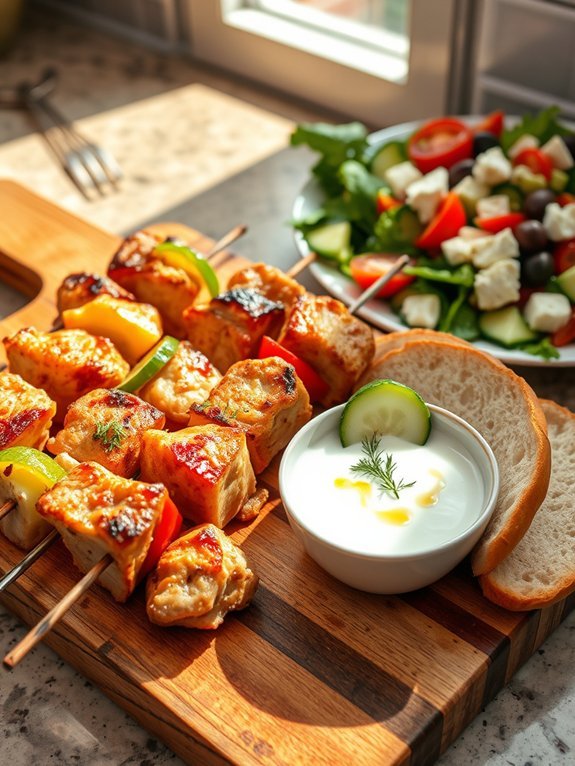
Souvlaki is a beloved Greek dish that features marinated meat skewered and grilled to perfection. Traditionally made with pork, chicken, or lamb, the meat is seasoned and grilled until smoky and juicy, often served with pita bread, fresh vegetables, and a variety of sauces. Souvlaki isn’t only a favorite street food but also a versatile option for any home cook looking to bring a taste of Greece to their dining table.
In addition to the succulent meat, souvlaki can be complemented with tzatziki sauce, a revitalizing yogurt-based dip, and a side of Greek salad for a complete meal. Whether enjoyed at a local taverna or prepared at home, making souvlaki is a straightforward process that captures the essence of Greek cuisine and brings delightful flavors to the table.
Ingredients:
- 1 pound of pork shoulder, chicken breast, or lamb
- 1/4 cup olive oil
- 2 tablespoons lemon juice
- 3 cloves garlic, minced
- 1 teaspoon dried oregano
- 1 teaspoon salt
- 1/2 teaspoon black pepper
- Wooden or metal skewers
- Pita bread for serving
- Tzatziki sauce (optional)
- Fresh vegetables (tomatoes, onions, and lettuce for serving)
Cut the meat into 1-inch cubes. In a bowl, combine olive oil, lemon juice, minced garlic, oregano, salt, and black pepper to create a marinade.
Add the meat cubes into the marinade, making sure they’re well-coated. Cover and let the mixture marinate in the refrigerator for at least 1 hour, or ideally overnight for deeper flavor.
Thread the marinated meat onto the skewers, then preheat a grill or grill pan over medium-high heat. Grill the kebabs for about 10-15 minutes, turning occasionally, until cooked through and slightly charred.
When making souvlaki, consider using a meat thermometer to verify perfect doneness—chicken should reach 165°F, while pork and lamb can be enjoyed at 145°F.
For added depth of flavor, you can also experiment with different marinades, including yogurt-based ones. Don’t hesitate to serve the souvlaki with additional toppings such as feta cheese or olives for an authentic Greek experience. Enjoying these skewers directly off the grill is a must for the ultimate taste!
Tzatziki
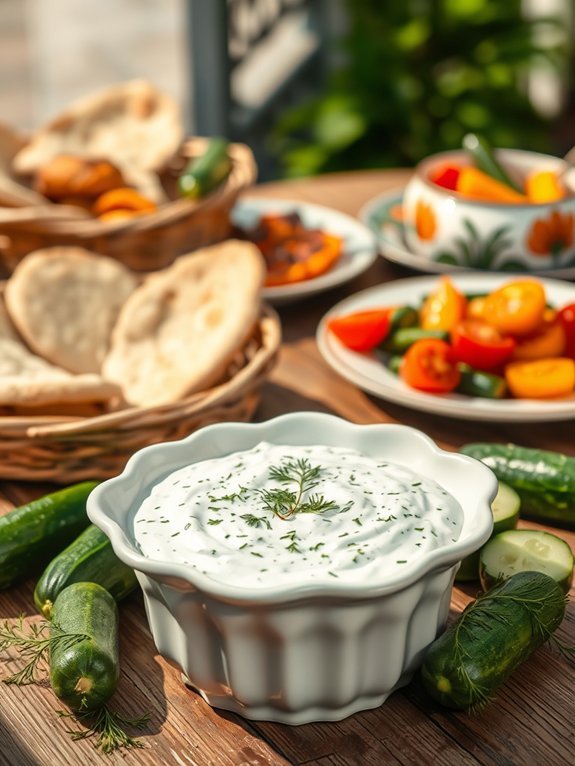
Tzatziki is a classic Greek dip that wonderfully balances creamy yogurt with revitalizing cucumbers and aromatic garlic, making it a favorite accompaniment for various dishes or a delightful standalone spread. Its vibrant flavors embody the essence of Greek cuisine and are perfect for enhancing grilled meats, pita bread, or fresh vegetables. This dish is easy to prepare and often served chilled, making it an ideal appetizer for warm summer days or lively gatherings.
To create the perfect tzatziki, quality ingredients play a pivotal role. Traditional recipes emphasize the use of thick Greek yogurt for a creamier texture, and fresh herbs such as dill or mint elevate its flavor profile. Grated cucumbers should be drained to avoid an overly watery dip, allowing for a balance of creaminess and freshness. Once prepared, tzatziki can be stored in the fridge for a day or two, allowing the flavors to meld beautifully together.
- 1 cup of thick Greek yogurt
- 1 medium cucumber
- 2 cloves of garlic, minced
- 1 tablespoon of olive oil
- 1 tablespoon of white wine vinegar or lemon juice
- 1 tablespoon of fresh dill (or mint), finely chopped
- Salt, to taste
- Pepper, to taste
To prepare the tzatziki, start by grating the cucumber using a box grater. After grating, sprinkle a pinch of salt over the cucumber, let it sit for about 10 minutes, then squeeze out the excess liquid using a clean kitchen towel or cheesecloth.
In a medium bowl, combine the drained cucumber, Greek yogurt, minced garlic, olive oil, vinegar or lemon juice, and fresh dill. Mix well until all ingredients are evenly incorporated. Taste and adjust salt and pepper to your preference. Cover and chill in the refrigerator for at least an hour before serving.
When making tzatziki, feel free to experiment with additional flavors or textures. For a spicier twist, you can add a pinch of crushed red pepper flakes or a dash of hot sauce. If you prefer a thicker dip, opt for labneh instead of Greek yogurt or simply use less cucumber.
Always remember to taste and adjust the seasoning before serving; the dip should have a nice balance of tanginess from the yogurt and brightness from the herbs. Enjoy your homemade tzatziki with a variety of dishes for a revitalizing touch!
Spanakopita
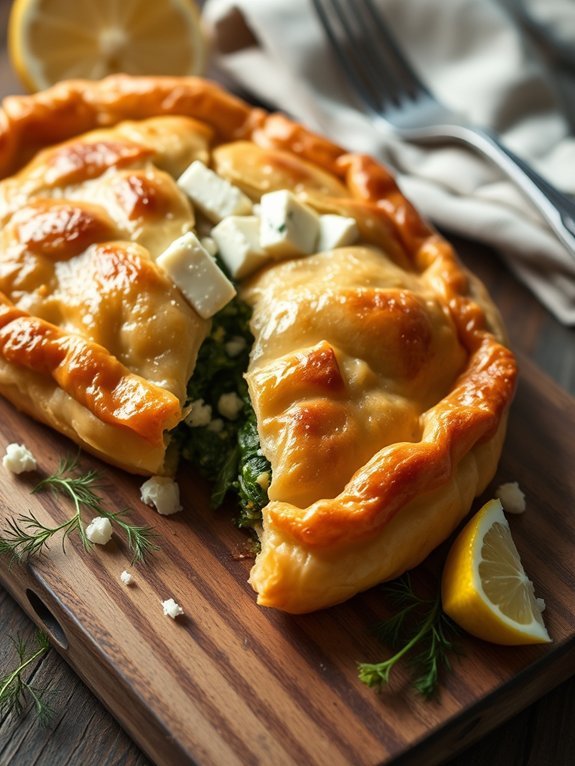
Spanakopita, also known as spinach pie, is a traditional Greek dish that beautifully combines layers of flaky phyllo pastry with a savory spinach and feta filling. The delicate textures and rich flavors make it a favorite among both locals and visitors alike.
Originating from the Mediterranean region, this dish isn’t only a staple at festive occasions but also makes for a delightful everyday meal or appetizer.
Making spanakopita is an excellent way to use fresh spinach, which is abundant in Greek cuisine. This dish offers a perfect balance of nutrients, as spinach provides numerous health benefits, including iron and vitamins A and C, while feta cheese contributes a delicious tangy flavor.
The crispy phyllo pastry envelops the flavorful filling, creating a satisfying dish that can be enjoyed hot or cold.
Ingredients:
- 1 lb fresh spinach (or 10 oz frozen, thawed and drained)
- 1 cup crumbled feta cheese
- 1/2 cup ricotta cheese (optional)
- 1 small onion, finely chopped
- 2-3 green onions, chopped
- 2 cloves garlic, minced
- 1/4 cup fresh dill, chopped (or 1 tablespoon dried dill)
- 2 teaspoons olive oil
- 1 package of phyllo pastry (about 16 oz)
- 1/2 cup melted butter or olive oil (for brushing)
- Salt and pepper, to taste
Preheat your oven to 375°F (190°C).
In a large skillet, heat olive oil over medium heat and sauté the onions until soft. Add the minced garlic and spinach, cooking until the spinach wilts (if using fresh) or is thoroughly heated (if using frozen).
Remove from heat, let it cool slightly, then stir in the feta cheese, ricotta (if using), dill, and season with salt and pepper.
Lay the phyllo pastry sheets flat on a clean surface, brushing each layer lightly with melted butter.
Place a thin line of the spinach mixture at one end of the pastry and fold it into a triangle shape, folding and tucking as you go, until you reach the end.
Brush the top with more butter and place the triangles on a baking sheet. Bake for 25-30 minutes or until golden brown.
When working with phyllo pastry, it’s important to keep it moist to prevent it from drying out. You can do this by covering unused sheets with a damp cloth while you work.
Additionally, feel free to experiment with the filling by adding ingredients like leeks, mushrooms, or other herbs to tailor the taste to your preference.
Spanakopita can also be made in a large pan and cut into squares, making it perfect for sharing at parties or gatherings.
Recommended Items
Get ready to elevate your culinary experience with these essential products and tools for making delightful Greek dishes!
Products
Dolmades
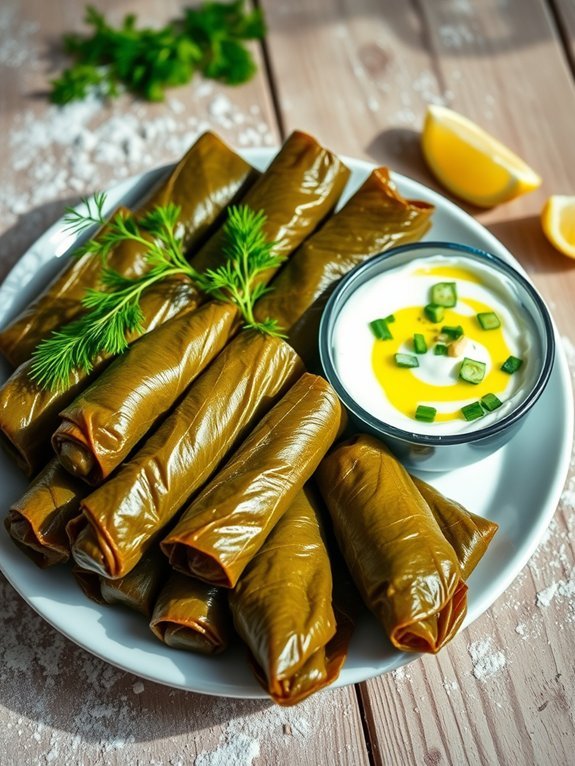
Dolmades, the beloved stuffed grape leaves, are a staple in Greek cuisine and a deliciously satisfying dish that showcases the country’s culinary heritage. Traditionally enjoyed as an appetizer or meze, dolmades are versatile, making them perfect for gatherings or a casual family meal. The dish features tender grape leaves wrapped around a filling typically made of rice, herbs, and sometimes meat, infused with the vibrant flavors of lemon and olive oil.
Serving dolmades with a side of yogurt or tzatziki can elevate the experience, allowing you to taste the revitalizing complement of creamy, tangy goodness. The beauty of dolmades lies in their adaptability. Though classic recipes call for a rice-and-herb filling, you can easily customize them by adding ground lamb or beef for a heartier version. They can be served warm or at room temperature, making them an excellent dish for any season.
Dolmades aren’t only delicious but also quite impressive when presented, as the tightly rolled grape leaves create an appealing visual treat that’s sure to impress your guests.
Ingredients:
- 1 jar of grape leaves in brine (about 60 leaves)
- 1 cup rice (short or medium-grain)
- 1 medium onion, finely chopped
- 1/4 cup fresh parsley, chopped
- 1/4 cup fresh dill, chopped
- 1/4 cup olive oil
- 1 lemon (juiced)
- 1/2 tsp salt
- 1/2 tsp black pepper
- 1 1/2 cups vegetable or chicken broth
Rinse the grape leaves under cold water and set them aside to dry. In a skillet, heat half of the olive oil over medium heat, then add the onion and sauté until soft. Stir in the rice, parsley, dill, lemon juice, salt, and pepper; cook for 2 minutes.
Add 1 cup of broth and bring to a simmer. Reduce heat, cover, and cook for 10-15 minutes until rice is partially cooked. Once done, allow the mixture to cool slightly. Lay a grape leaf on a flat surface, place about a tablespoon of the filling near the stem end, fold over the sides, and roll tightly. Repeat until all filling is used.
Place the rolls in a large pot, seam-side down, layering them as necessary. Pour the remaining broth and olive oil over the top. Cover with a plate to keep them submerged, and bring to a simmer. Cover and cook on low heat for about 45 minutes.
When making dolmades, make sure that the grape leaves are tender. If you use fresh grape leaves, blanch them briefly in boiling water to soften. For a more intense flavor, consider adding ground meat to the filling or adjusting spices to suit your taste.
Allow dolmades to rest for a few minutes after cooking before serving; this helps the flavors meld together beautifully. Finally, don’t forget to serve them with a generous dollop of tzatziki or Greek yogurt for the ultimate experience!
Pastitsio
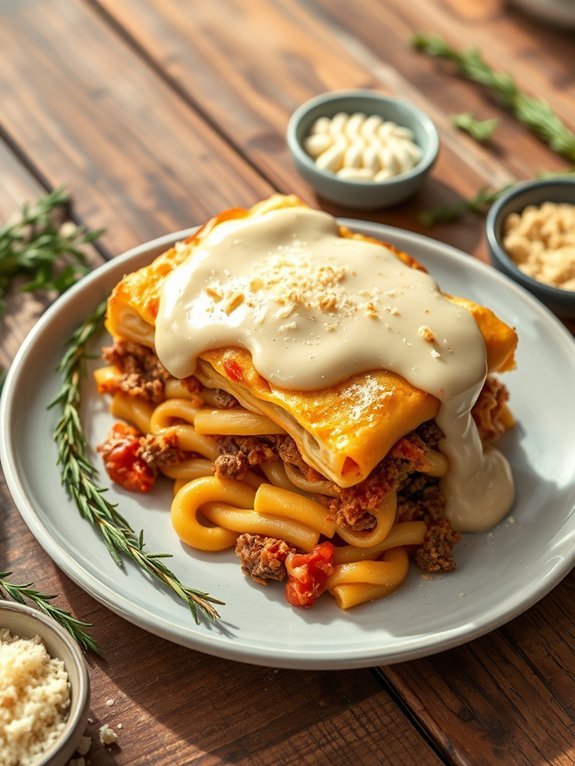
Pastitsio is a beloved Greek casserole, often described as a delightful blend of Mediterranean flavors. This hearty dish features layers of pasta, a rich meat sauce, and creamy béchamel, resulting in a comforting meal that’s perfect for family gatherings or special occasions. Its origins can be traced back to various adaptations of pasta dishes throughout history, but pastitsio has established itself as a quintessential part of Greek cuisine, loved for its complex flavors and satisfying textures.
To make pastitsio, you’ll typically require a combination of baked ziti or tubular pasta called “bucatini.” The meat sauce, seasoned with aromatic spices, is often made with ground beef or lamb and enriched with tomatoes, garlic, and onions. Topped with a luxurious béchamel, this dish not only tantalizes the taste buds but also provides a wonderful creamy contrast to the hearty meat and pasta layers beneath.
Ingredients:
- 1 pound bucatini or ziti pasta
- 1 pound ground beef or lamb
- 1 onion, finely chopped
- 2 cloves garlic, minced
- 1 can (14 oz) crushed tomatoes
- 1 teaspoon cinnamon
- 1 teaspoon oregano
- Salt and pepper to taste
- 4 tablespoons olive oil
- 3 cups milk
- 3 tablespoons all-purpose flour
- 2 large eggs
- 1 cup grated Parmesan cheese
- ½ teaspoon nutmeg
- Butter for greasing the baking dish
Cook the pasta according to the package instructions until al dente, then drain and set aside. In a large skillet, heat olive oil over medium heat, and sauté the chopped onion until it becomes translucent. Add the minced garlic, followed by the ground meat, and cook until browned. Stir in the crushed tomatoes, cinnamon, oregano, salt, and pepper, and let the sauce simmer for 15-20 minutes.
Meanwhile, prepare the béchamel by melting 4 tablespoons of butter in a saucepan, whisking in the flour to make a roux, then gradually adding the milk while continuing to whisk until the mixture thickens. Remove from heat, and let it cool slightly before whisking in the eggs, nutmeg, and half of the Parmesan cheese.
When assembling your pastitsio, spread half of the pasta in a greased baking dish, followed by the meat sauce, then the remaining pasta, and top with the béchamel. Sprinkle the remaining Parmesan on top, and bake in a preheated oven at 350°F (175°C) for about 45 minutes, or until golden brown and bubbling. Let it cool slightly before serving to allow the layers to set.
For an authentic twist, consider adding a splash of red wine to your meat sauce while it simmers to enhance the flavor further. Additionally, some people like to add a bay leaf during the cooking process for an aromatic touch.
Pastitsio is typically best enjoyed a day after it’s made, as the flavors meld beautifully overnight, and the dish becomes easier to slice and serve. If you’re preparing this dish in advance, feel free to assemble it a day ahead and bake it just before serving!
Step-by-Step Cooking Guide
Feta Cheese

Feta cheese is a beloved ingredient in the Mediterranean diet and is essential in many Greek dishes. This tangy, brined cheese is made primarily from sheep’s milk and provides a creamy texture and distinctive flavor that can elevate a variety of meals. Whether crumbled over salads, baked into savory pastries, or served in traditional dishes like Spanakopita and Greek Salad, feta cheese has a versatility that makes it a kitchen staple.
In this recipe, we’ll prepare a simple yet delicious Greek-style baked feta dish that showcases the cheese in a warm, flavorful context. The combination of herbs, spices, and vegetables will perfectly complement the rich creaminess of the feta, providing a delightful balance that’s both satisfying and easy to make. Serve it as an appetizer with crusty bread or as a flavorful addition to a main course.
Ingredients:
- 200g feta cheese
- 2 tablespoons olive oil
- 1 teaspoon dried oregano
- 1 teaspoon red pepper flakes (optional)
- 1 red bell pepper, sliced
- 1 zucchini, sliced
- 1 small red onion, sliced
- Fresh parsley for garnish
- Black pepper to taste
Preheat your oven to 200°C (400°F). In a baking dish, arrange the sliced vegetables (bell pepper, zucchini, and red onion) as a bed, drizzling them with olive oil, and seasoning with black pepper, dried oregano, and red pepper flakes.
Place the whole block of feta cheese on top of the vegetables and drizzle with a little more olive oil. Bake in the preheated oven for about 20 minutes, or until the feta is heated through and slightly golden. Remove from the oven and garnish with fresh parsley before serving.
For the best flavor, try to use high-quality feta cheese, preferably one that’s Greek for authenticity. Feel free to customize the dish by adding other vegetables like cherry tomatoes or olives, and adjust the level of spice according to your taste preferences.
You can also experiment with different herbs, such as fresh oregano or thyme, for a unique twist. Finally, enjoy the baked feta with some warm pita bread or as part of a larger mezze platter; it’s a crowd-pleaser!
Greek Salad
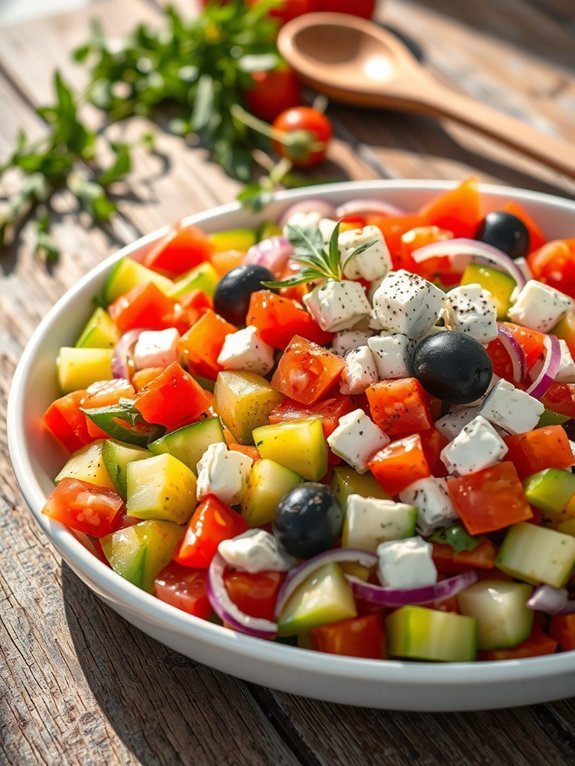
Greek salad, or Horiatiki, is a vibrant and invigorating dish, characterized by its simple yet bold flavors. Originating from the Greek countryside, this salad is often enjoyed as an accompaniment to grilled meats or as a light meal on its own. The combination of fresh vegetables, tangy feta cheese, and a drizzle of olive oil brings the essence of Greek cuisine right to your table.
Perfect for warm weather, Greek salad is a staple in Mediterranean diets and is loved for its health benefits as well.
To create a truly authentic Greek salad, it’s essential to select the freshest vegetables you can find. Crisp cucumbers, ripe tomatoes, and crunchy bell peppers form the base of this beautiful dish. The addition of juicy olives and creamy feta cheese not only adds flavor but also helps to put together a colorful presentation.
Whether served as an appetizer or a main dish, Greek salad is sure to please any palate.
- 2 medium ripe tomatoes, chopped
- 1 cucumber, peeled and chopped
- 1 bell pepper (preferably green), sliced
- 1 small red onion, thinly sliced
- 200g feta cheese, crumbled or in blocks
- A handful of Kalamata olives
- 3 tablespoons extra virgin olive oil
- 1 tablespoon red wine vinegar
- Salt and black pepper to taste
- Fresh oregano or dried oregano for garnish
In a large bowl, combine the chopped tomatoes, cucumber, bell pepper, and sliced red onion. Gently toss the ingredients together before adding the feta cheese and olives on top.
In a small bowl, whisk together the olive oil, red wine vinegar, salt, and pepper, then pour it over the salad. Toss everything together just before serving, making sure to retain the feta and olives on top for presentation.
When preparing Greek salad, it’s important to use high-quality, fresh ingredients to enhance the flavors. Feel free to adjust the ingredients based on your personal preferences, such as adding more olives or using different types of cheese.
Additionally, if you want to add a twist, consider tossing in some capers or sliced avocado. Remember that traditional Greek salad doesn’t include lettuce, but you can incorporate it if you desire additional greens.
Enjoy your homemade Greek salad alongside your favorite dish, and don’t hesitate to experiment with seasonal vegetables!
Gyro
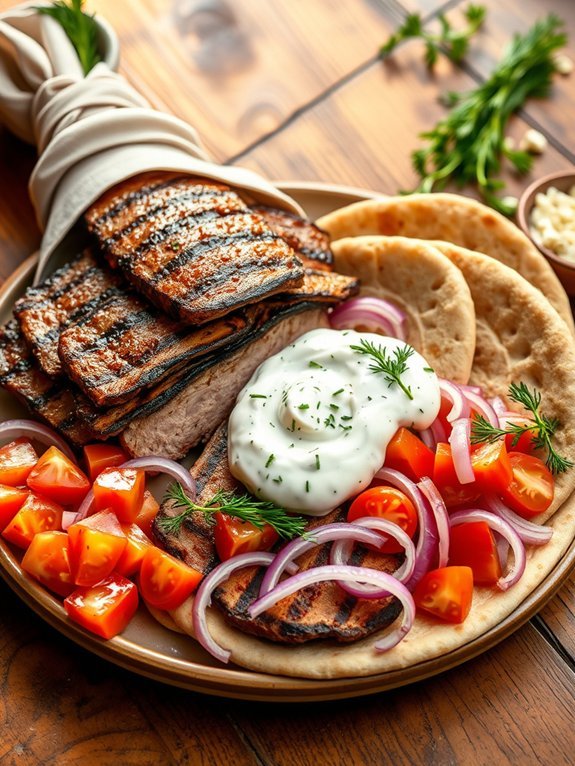
Gyros are a quintessential Greek street food known for their flavorful combination of marinated meat, fresh vegetables, and tangy sauces, all wrapped in warm pita bread. Traditionally, gyros are made using pork, chicken, or lamb, which is cooked on a vertical spit, allowing the outer layer to crisp up while the inside remains tender and juicy. This dish is often served with a variety of toppings including tomatoes, onions, and a creamy tzatziki sauce, making it a satisfying and delicious meal.
Making gyros at home can be a rewarding experience, as it allows you to customize the ingredients and tailor the flavors to your liking. While authentic gyros cooking typically involves specialized equipment, it’s possible to create a similar taste and texture using a grill or oven at home. With the right marinade and preparation, you can enjoy a taste of Greece in your kitchen.
Ingredients:
- 1 pound pork shoulder (or chicken/lamb)
- 3 tablespoons olive oil
- 2 teaspoons dried oregano
- 1 teaspoon garlic powder
- 1 teaspoon onion powder
- 1 teaspoon paprika
- Salt and pepper, to taste
- 4 pita breads
- 1 cup chopped tomatoes
- 1 onion, thinly sliced
- 1 cup tzatziki sauce (store-bought or homemade)
Cut the meat into thin slices and marinate it in olive oil, oregano, garlic powder, onion powder, paprika, salt, and pepper for at least 2 hours (preferably overnight). If you have a grill, preheat it to medium-high and grill the seasoned meat until cooked through and slightly charred, about 5-7 minutes per side.
If using an oven, spread the meat on a baking sheet and roast at 400°F (200°C) for 25-30 minutes, turning halfway through. Once cooked, let the meat rest, then slice thinly and serve on warm pita bread topped with tomatoes, onions, and tzatziki sauce.
To enhance the flavor of your gyros, consider toasting the pita bread slightly before assembling the dish. Additionally, allow the meat to rest for a few minutes after cooking to guarantee it remains juicy.
If you’re making tzatziki sauce from scratch, mixing in some grated cucumber can add a revitalizing crunch. Feel free to experiment with toppings like lettuce, feta cheese, or hot sauce to make your gyros uniquely delicious.
Keftedes

Keftedes, the beloved Greek meatballs, are a fantastic way to enjoy a burst of Mediterranean flavors in every bite. These tender and juicy morsels are often made with a mixture of ground meat, herbs, spices, and a hint of garlic, then rolled into small balls and deep-fried or baked to perfection. Traditionally served with a side of tzatziki sauce or as part of a meze platter, keftedes are an absolute must-try for anyone looking to explore the rich culinary heritage of Greece.
In addition to their mouthwatering taste, keftedes are remarkably versatile. You can serve them as an appetizer, a sandwich filling, or even add them to a hearty salad for a complete meal. They can also be customized according to personal taste or dietary preferences, making them a favorite in Mediterranean homes. With this recipe, you can easily bring the authentic flavor of keftedes to your kitchen and impress your friends and family with a delightful Greek feast.
Ingredients:
- 1 pound ground beef (or a mixture of beef and pork)
- 1 small onion, finely chopped
- 2 cloves garlic, minced
- 1/2 cup fresh parsley, chopped
- 1 teaspoon dried oregano
- 1 teaspoon ground cumin
- 1/2 cup breadcrumbs
- 1/4 cup grated Parmesan cheese
- 1 egg, beaten
- Salt and pepper to taste
- Olive oil for frying
- Lemon wedges for serving
In a large mixing bowl, combine the ground meat, onion, garlic, parsley, oregano, cumin, breadcrumbs, Parmesan cheese, beaten egg, salt, and pepper. Mix everything well until fully incorporated.
Once your mixture is ready, shape it into small balls, roughly the size of a golf ball. Heat olive oil in a large frying pan over medium heat, and fry the keftedes in batches until they’re golden brown and cooked through, about 5-7 minutes per batch. Remove them from the pan and let them drain on paper towels before serving with lemon wedges and tzatziki sauce.
When making keftedes, feel free to experiment with the spices and herbs according to your taste. You can also bake them for a healthier option—just place the formed meatballs on a baking sheet lined with parchment paper, lightly brush with olive oil, and bake at 400°F (200°C) for about 20-25 minutes or until cooked through.
Additionally, allowing the mixture to rest in the fridge for at least an hour before cooking can help enhance the flavors and improve the texture of the meatballs. Enjoy your keftedes with a revitalizing Greek salad for a complete meal!
Baklava

Baklava is a deliciously rich pastry that has been a staple in Greek cuisine for centuries. Made with layers of flaky phyllo dough, finely chopped nuts, and sweet syrup, it’s a perfect dessert for special occasions and celebrations. The combination of textures and flavors creates a unique tasting experience, with the nutty crunch juxtaposed against the syrupy sweetness that seeps into each layer.
To prepare baklava, one must be patient, as it requires careful layering of the phyllo and meticulous attention to achieve the perfect balance of flavors. Traditionally, walnuts or pistachios are used as the nut filling, but you can experiment with different nuts as per your preference. The rich aroma that fills your kitchen while making this dessert is only a hint of the deliciousness that awaits when you take that first bite.
Ingredients:
- 1 package (16 oz) phyllo dough
- 1 cup unsalted butter, melted
- 2 cups walnuts or pistachios, finely chopped
- 1 cup granulated sugar
- 1 teaspoon ground cinnamon
- 1 cup water
- 1 cup honey
- 1 teaspoon vanilla extract
To make baklava, start by preheating your oven to 350°F (175°C). Grease a 9×13 inch baking dish with butter. In a bowl, mix the chopped nuts, sugar, and cinnamon. Lay a sheet of phyllo dough in the dish, brush it with melted butter, and repeat this process for about 8 layers. Evenly spread a portion of the nut mixture over the phyllo. Continue layering 4 or more sheets of phyllo, followed by another layer of nuts, and repeat until all ingredients are used, finishing with several layers of phyllo on top.
Once assembled, cut the baklava into diamond or square shapes before baking it for about 40-45 minutes until golden brown. Meanwhile, combine water, honey, and vanilla in a saucepan, bringing it to a boil. Pour the syrup over the hot baklava as soon as it comes out of the oven, allowing it to soak in and cool before serving.
When preparing baklava, it’s vital to work quickly with phyllo dough, as it can dry out easily. Cover the unused sheets with a damp cloth while you work to keep them moist. If you want to enhance the flavor, consider adding a splash of orange blossom water or rose water to the syrup.
Properly storing baklava is also important; it will keep well at room temperature in an airtight container for a week, allowing the flavors to deepen over time. Enjoy making this delightful dessert that’s sure to impress family and friends alike!
Loukoum
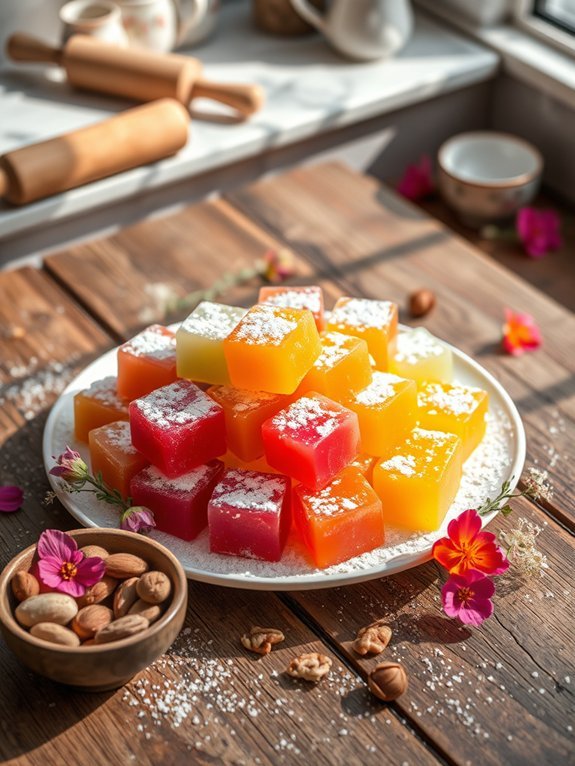
Loukoum, also known as Turkish delight, is a candy that has roots in Greek cuisine. This sweet confection is characterized by its gel-like consistency and can be flavored with various ingredients such as rosewater, lemon, or mastic. Traditionally, loukoum is served in small cubes dusted with powdered sugar or cornstarch, making it perfect for savoring after a meal or enjoying with coffee and tea.
The process of making loukoum may seem intricate, but with a little patience, you can create this delightful treat at home. To begin, you’ll need to gather the necessary ingredients that work together to produce the signature chewy texture of loukoum. The key to achieving the right consistency lies in the meticulous cooking and cooling processes. Once you’ve mastered this recipe, you can experiment with various flavors and toppings to make the loukoum uniquely yours.
So roll up your sleeves, gather your ingredients, and let’s get started on making this delicious Greek sweet!
- 1 cup sugar
- 1/2 cup water
- 1/4 cup cornstarch
- 1/4 cup lemon juice
- 1 tsp rosewater (or flavored extract of choice)
- 1/2 tsp citric acid
- 1/4 tsp salt
- 2 tbsp powdered sugar (for dusting)
- 2 tbsp cornstarch (for dusting)
In a saucepan, combine the sugar, water, and lemon juice, then bring to a boil over medium heat, stirring until the sugar dissolves. In a separate bowl, mix the cornstarch with 1 cup of water until smooth. Gradually add this mixture to the boiling syrup, stirring continuously.
Reduce the heat to low and cook for about 15-20 minutes, or until the mixture thickens and reaches a gelatinous consistency. Remove from heat and stir in the rosewater, citric acid, and salt. Pour the mixture into a greased pan and let it cool completely before cutting it into cubes and dusting with powdered sugar and cornstarch.
When making loukoum, be aware that patience is key. Make sure to stir continuously to prevent the mixture from burning or sticking to the pan. Additionally, allow enough time for the loukoum to cool completely before cutting, as this will help achieve a firmer texture.
Experiment with different flavors like orange blossom or pistachio, and consider using nuts or coconut for additional texture on the exterior. Enjoy your homemade loukoum with friends and family or give them as a delightful and personal gift!










